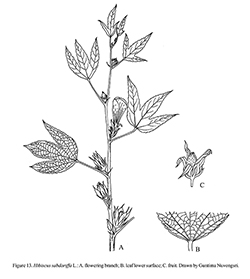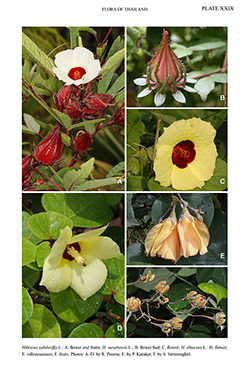e-Flora of Thailand
Volume 14 > Part 2 > Year 2019 > Page 306 > Malvaceae > Hibiscus
15. Hibiscus sabdariffa L.wfo-0000723020
Sp. Pl. 2: 695. 1753; Mast. in Hook.f., Fl. Brit. India 1: 340. 1874; Merr., Fl. Manila: 332. 1912; Burkill, Dict. 1: 1170. 1935; S.Y.Hu, Fl. China, 153: 58 t. 21 f. 6. 1955; Backer & Bakh.f., Fl. Java 1: 431. 1963; Neal, Gard. Hawaii, ed. 2: 557. 1965; Borss.Waalk., Blumea 14.1: 64. 1966; Kirtikar et al., Ind. Med. Pl.: 329. 1980; Sivar. & Pradeep, Malvaceae S. Penins. India: 114. 1996; Y.Tang et al. in C.Y. Wu et al., Fl. China 12: 293. 2007. Fig. 13. Plate XXIX: A.
Accepted Name : This is currently accepted.
Description : Annual herb to 2 m tall; stems subglabrous, purplish; epicalyx and calyx fleshy, reddish. Leaves polymorphic, 8–15 by 7–12 cm, usually 3–5-lobed, lobes lanceolate, base cuneate, apex acuminate, margin serrate, palmately 3–7-veined, with a gland near base of midnerve on lower surface, glabrous on both surfaces. Petiole 2–12 cm long. Stipules linear, 0.5–1 cm long, sparsely villous, caducous. Flower axillary, solitary; peduncles subsessile to 1.5 cm long, covered with long stellate hairs. Epicalyx lobes 8–12, lanceolate, 1–2 cm long, long simple hairs on margin, adnate to base of calyx tube. Calyx cup-shaped; tube 1–1.5 cm long; lobes lanceolate, 1.5–2.5 by 0.5–1 cm, 3-nerved, each lobe with a gland at base of midnerve; outer surface sparsely stellate and simple hairy, inner surface villose. Corolla widely campanulate, pale yellow or pale pink with dark red centre. Petals obovate, 2.5–4 by 2–3 cm, subglabrous. Staminal column 1.5–2 cm long; antheriferous throughout. Ovary ovoid, 5-lobed. Style 2.5–3 cm long; stigma capitate. Capsules ovoid, shortly beaked, 1.5–3 cm long, coarsely hairy, enveloped by red fleshy calyx. Seeds many, reniform, ca 5 mm in diam., brown, glabrous.
Thailand : NORTHERN: Chiang Mai, Phrae; SOUTH-EASTERN: Chon Buri (Sattahip, Si Racha); CENTRAL: Krung Thep Maha Nakhon (Bangkok); PENINSULAR: Phangnga, Songkhla.
Distribution : Cultivated throughout tropical regions. Origin probably in Africa.
Ecology : Sandy meadows, open forests.
Vernacular : Krachiap (กระเจี๊ยบ), krachiap daeng (กระเจี๊ยบแดง), krachiap priao (กระเจี๊ยบเปรี้ยว)(Central); phak keng kheng (ผักเก็งเค็ง), som keng kheng (ส้มเก็งเค็ง)(Northern), som taleng khreng (ส้มตะเลงเครง)(Tak); sompu (ส้มปู)(Shan-Mae Hong Son).
Uses: The plants are used as a vegetable; the calyx is used for jams, jellies and sorrel drink; young leaves provide a vegetable for curries. Seed-oil is used as a medicine; the residue is used for cattle-food and the fibre is used in cordage.


